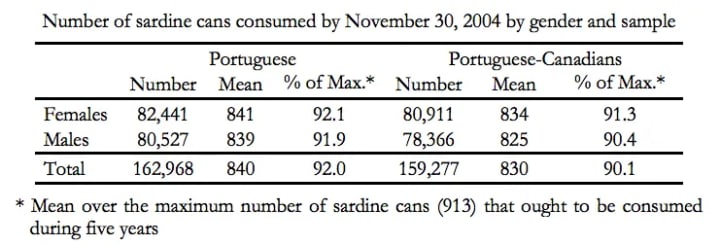The Impact of Sardine Consumption on Portuguese Longevity
A 20-Year Study

Abstract
Over the past nine millennia, people living in Lusitania, which now encompasses the modern nation-state of Portugal, have been consuming sardines. The Portuguese, both men and women, tend to live longer when extraneous factors are taken out of the equation. Several studies have presented data in support of the sardine consumption-longevity dyad. In the present study, 200 Portuguese and 200 Canadians of Portuguese ancestry were assessed for their sardine consumption habits. It was hypothesised that those consuming more sardines will tend to live longer than those consuming fewer sardines or none, and that expected gender differences pertaining to longevity would be eliminated. While both hypotheses can only find definite support following the postponed demise of the entire sample of 400 individuals in the many years to come, preliminary results seem to offer support in both cases.
Introduction
Longevity, whether Methuselahan or centennial, captures our attention more than anything else, including death. Considerable attention is also devoted to life expectancy, which, unlike longevity, is a statistical estimate. Gender differences, always an issue, remain one in this contest of existential durability. Women have always lived longer in the records of all periods. However, they are less likely to be married and much more likely to be widowed and live alone than older men. (For a review of this literature see Long & Short, 2002). Most studies measuring longevity have shown women outliving men in every country and in every culture. However, studies that also incorporated sardine consumption found women and men to be living equally long (Fraga & Pimentel, 1992; Pimentel & Fraga, 1990). These studies suggest that sardine consumption may be the ingredient that ordains longevity, gender notwithstanding. Consuming sardines on a regular basis may provide the elixir always sought after for long life. The hypothesis to be tested in this study is that the simple addition of a few sardines to a daily diet will increase life expectancy and thus longevity, minimising or eliminating the gender differences usually associated with it.
Various approaches to the problem of longevity and gender inequality have been used in several studies since Comprido (1984) reported that most of her Portuguese undergraduate and graduate students had grandparents, grandmothers and grandfathers, not only alive but in good health. The common factor accounting for their survival seemed to be sardine consumption. Using a component consumption analysis, Longa (2002) reviewed 18 such studies carried out between 1984 and 2000, all reporting regular sardine consumption as a correlate of long life for both women and men. Available theories meant to account for this positive outcome were all chemical (e.g., calcium, phosphorus, potassium, and omega-3 fatty acids). In another study, Pescado (2003) examined the effect of the high intake of sardines on the general health of 89 male and 189 female nursing home residents. All participants were in better health following a six-month regimen of adding a can of sardines to lunch or supper every day.
Over the past few decades, an increasing number of physiological functions have been attributed to omega-3 fatty acids, including movement of calcium and other substances into and out of cells, relaxation and contraction of muscles, inhibition of clotting, regulation of the secretion of substances that include digestive enzymes and hormones, control of fertility, cell division, and growth. Moreover, omega-3 fatty acids also play an important role in brain development and function.
The present study proceeds on the assumption that the common failure to live a long life stems from the fact that most consumption habits lack a minimum, regular intake of calcium and omega-3 fatty acids. To test this hypothesis, the present study involved the addition of a can of sardines, or the fresh equivalent, every other day to a regular diet. It was anticipated that with the addition of these sardines, which were expected to maximise the normal functioning of the body, observed life expectancy would increase and gender differences would decrease.
Method
Participants
A convenience sample of 200 Portuguese (100 females and 100 males) from Lisbon, Portugal, most of them approached in various restaurants, and a convenience sample of 200 Canadians of Portuguese descent (100 females and 100 males) from Montreal, most of them approached within the confines of the Portuguese community, voluntarily participated in this study. Age ranged from 58 to 89 years (Mean = 68.4 years, Standard Deviation [SD]= 5.7 years).
Materials
Each participant was given a one-page questionnaire in Portuguese or English consisting of a short introductory note regarding the nature of the study, followed by demographic questions concerning gender, age, occupation, current health problems, and language spoken at home. A short paragraph instructed the participants about the actual task of consuming a can of sardines, or the fresh equivalent, every other day for the next 20 years. The following paragraph informed the participants about the nutritional value of sardines, especially the abundance of omega-3 fatty acids and their ability to facilitate brain development and function, cell division, growth, and the movement of calcium and other substances into and out of cells, as well as relax and contract the muscles, inhibit clotting, regulate the secretion of substances that include digestive enzymes and hormones, and control fertility. Participants were then asked to indicate the number of sardine cans or the fresh equivalent that they consumed each month. Finally, they were directed to a central location where they could pick up 30 cans of sardines free of charge every two months for the next 20 years.
Procedure
All participants were asked to begin the experiment on December 1st, Portugal’s Independence Day, 1994, by consuming the first can of sardines and then consuming the following can of sardines every other day until November 30, 2014. Sardine consumption reminders were scheduled to be sent every year before December 1st.
Results
Five years into the study, on November 30, 1999, out of the 100 female and 100 male Portuguese participants, 99 females (99%) and 97 males (97%) were still alive, and out of the 100 female and 100 male Portuguese-Canadian participants, 98 females (98%) and 95 males (95%) were still alive. The cause of death for all 11 deceased participants was accidental (i.e., car crash in five cases, precipitous fall in two cases, violent assault in one case, drowning in one case, avalanche in one case, and electrocution in one case). Gender differences were statistically insignificant.

Most participants, both in Portugal and Canada, rigorously followed the sardine regimen. The great majority of participants picked up their bimonthly allowance of sardine cans, while a minority of them (less than 3%) acquired the sardines on their own.

Ten years into the study, on November 30th, 2004, out of the initial 100 female and 100 male Portuguese participants, 98 females (98%) and 96 males (96%) were still alive, and out of the initial 100 female and 100 male Portuguese-Canadian participants, 97 females (97%) and 95 males (95%) were still alive. The cause of death for the three additionally deceased participants was also accidental (i.e., car crash in one case, boat collision in one case, and lightening in one case). Gender differences were again statistically insignificant.

Most participants, both in Portugal and Canada, again rigorously followed the sardine regimen. The great majority of participants continued to pick up their bimonthly allowance of sardine cans, while a minority of them (less than 2%) kept acquiring the sardines on their own.

Discussion
After ten years of daily sardine consumption, the large majority of participants (96.5%) were still alive and well, and gender differences were statistically insignificant. There were no statistically significant differences between the Portuguese and Portuguese-Canadian samples. The next ten years will prove more conclusive either way.
Participants with moderate-to-serious health problems at the beginning of the study had their wellbeing change for the better, whereas those with minor health problems at the beginning of the study saw them virtually disappear.
Those consuming sardines on a regular basis may tend to live longer than those consuming fewer sardines or none. Furthermore, gender differences in terms of longevity may become a thing of the past.
The effects of the addition of sardines to our regular nutrition need to be examined further. The second phase of this study as well as other research may add more reliability and validity to the study’s hypotheses.
References
Comprido, I. (1984). Did sardines keep my students’ grandparents alive and well? Portuguese Journal of Social Science, 3, 111–117.
Fraga, P., & Pimentel, F. (1992). Men live as long as women: The benefits of consuming sardines. Journal of Longevity, 7, 42–49.
Long, I. M., & Short, M. E. (2002). The price women have paid and are still paying for living longer. Journal of Women’s Health and Gender-Based Medicine, 13, 154–162.
Longa, N. O. (2002). Sardine consumption as a correlate of long life: A review. Nutrition, 8, 343–353.
Pescado, L. (2003). The effects of sardine consumption on the health of nursing home residents. Geriatrics & Gerontology, 11, 177–186.
Pimentel, F., & Fraga, P. (1990). Men could live as long as women: The benefits of consuming sardines. Journal of Longevity, 5, 13–22.
Author Note
The author wishes to express his thanks to all participants, both in Portugal and Canada. May they live to consume at least ten more years’ worth of sardines!
About the Creator
Patrick M. Ohana
A medical writer who reads and writes fiction and some nonfiction, although the latter may appear at times like the former. Most of my pieces (over 2,200) are or will be available on Shakespeare's Shoes.






Comments
There are no comments for this story
Be the first to respond and start the conversation.